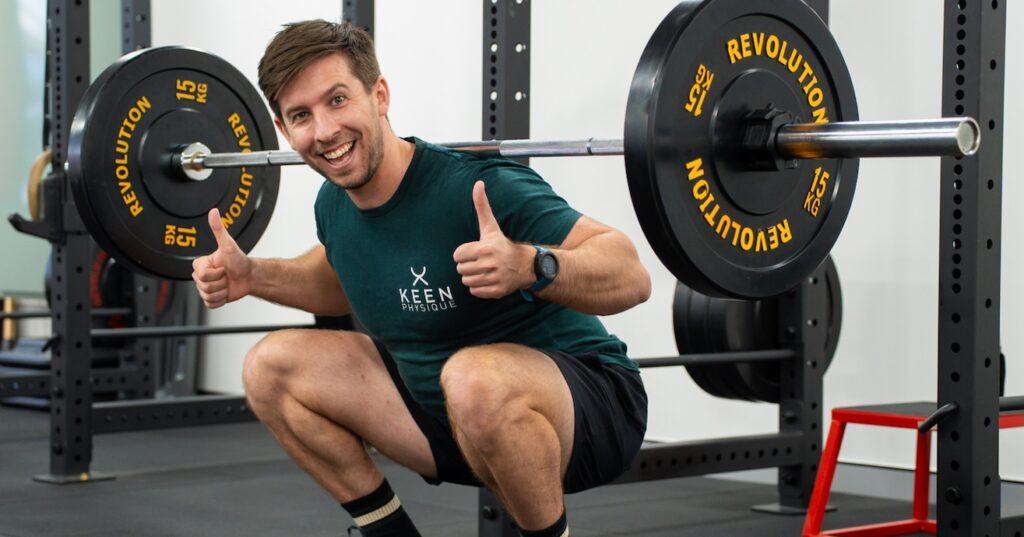
We Should All Train The Same
Seems like a bold statement, and I am exaggerating somewhat, but hear me out.
When I say “We should all train the same”, I don’t mean your program should be identical to a world champion marathon runner, or an elite level powerlifter.
What I DO mean is that EVERYONE’S training – regardless of age, occupation, or goals – should involve principles of strength training. Why? Because increased strength benefits all goals, and is the common denominator among the positive health outcomes to exercise.
Firstly, what is strength training?
Strength training is physical activity that aims to increase power output and – you guessed it – STRENGTH in our muscles. This is done by performing exercises against resistance, and can come in many forms, such as bodyweight/calisthenics, free weights and machines.
How does our body even get stronger?
In one word? Adaptation.
Effective strength training simply exposes the structures of your body to stimuli they’re not yet used to. A good way to think about this is by using the Goldilocks metaphor.
If the stimulus is too “cold” (resistance too low), there’s no need for structures to change as they can already manage that stress.
If the stimulus is too “hot” (resistance is too high), the load is too far beyond the capabilities of our body. It’s somewhat “out of the question”. This increases risk of technique breakdown and injury.
But when the stimulus is just right, and stresses that are just beyond what we’re capable of, the magic happens. The body is challenged just enough through suitable exercises, which causes change & adaptation.
And these adaptations don’t just occur at a muscular level. Other structures such as tendons and bones become thicker and stronger, and our cardiovascular system becomes more efficient relative to the stimulus.
We all just want to feel & move better, right?
Just like mechanics fix common car problems, or a GP sees common patient presentations, a personal trainer will encounter common goals across their client base. To explain how strength training helps all, let’s take a look at some common goals among the population:
“I want to reduce/lose”:
- Weight
- Body fat
- Pain
“I want to increase/gain”:
- Tone
- Flexibility/mobility
- Muscle mass
Obviously there are SO MANY MORE GOALS that people have, and so many more things exercise helps with. However, in my new client forms, the above is what tends to populate the goal-setting section.
With that in mind, lets look at the reported benefits of strength training:
- Increased muscle mass
- Increase bone mineral density
- Maintain/improve flexibility & balance
- Weight management
- Enhanced performance of everyday activities
- Reduced risk of injury
- Prevent/reduce cognitive decline
- Improved stamina/endurance
- Improved mental health
So how does strength training help EVERYONE?
As much as I’ve alluded to the fact that we have similarities in our goals and desires, I am cautious of not painting everyone with the same brush. We are all different, and there are nuances to what we deem as important or unimportant in life. I GET IT!
But as is the theme for all of my blogs and thoughts, as well as training philosophy, I don’t think it’s wrong to say that longevity is a shared goal among us all. I’m sure that all of us would deem living a life where we move and feel as good as possible for as long as possible a good thing.
I encourage all to do their own research, but it is no secret that the nine points listed above as “Benefits of strength training” are all things that positively influence ones longevity, and is supported ten times over in literature. I don’t want to extrapolate on everything otherwise you’ll be here all day, but I’ll quickly build on a few key points:
- Bone mineral density: having a fall later in life can be quite catastrophic. But strength and resistance training now = increased load through your skeleton = stronger bones
- Weight management: stronger muscles demand more energy to be maintained. Strength training = increased muscle mass = improved metabolism (a greater amount of calories/energy required to maintain bodyweight)
- Reduced risk of injury/pain: stronger muscles with thicker, more resilient tendons are a result of managing higher loads, ideally through a greater range of motion. This exposure allows your body to adapt to forces that perhaps once caused injury, but is now more than capable in managing greater shifts in position, direction, and load.
- Prevent cognitive decline: strength training involves learning complex movements, which is similar to learning any other skill. Skill learning is great for building connections within the brain to enhance memory, concentration, and mental performance. Additionally, if your strength is going up, it likely means you’re subscribed to other healthy habits such as adequate sleep and nutrition, which are also great for our brain and mental health.
If you’ve made it this far, I thank you. I hope I’ve provided a bit of clarity on this topic, and you’ve left feeling more educated on strength training.
What’s my next blog? Well, I can a hear a few of you saying “But Matt, strength training means big muscles, and I DON’T WANT BIG MUSCLES!” I hear you, and I will be debunking this in my next blog!
